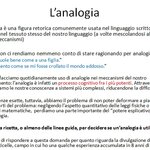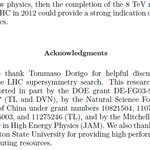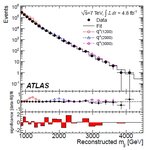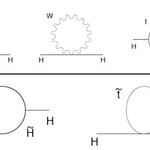Physics

You may have heard of superfluids and superconductors, so why not supersolids? In 2004 Moses Chan and Eunseong Kim thought they had discovered that super-cooled helium ice could essentially walk through walls – a defining characteristic of a supersolid.
The experiment was to make a cylinder with tiny nanopores in its walls, fill the pores with solid helium ice, suspend the cylinder from a torsional spring, and then give it a little twist. Like a kid on a swing set, the cylinder started rotating back and forth, with a frequency depending on its mass. As they…

See, this is what I really like of a blog: when readers contribute significantly!
I have discussed analogies here in the recent past, producing the writeup of a recent talk at a conference on the popularization of physics. I also singled out for an independent post a nice analogy to explain the problem of Naturalness (the "unnaturally low" mass of the Higgs boson and the resulting implications for new physics). Today a reader of this blog (signed "Ohwilleke") offered, in the comments thread of the writeup article, a much improved version of my "improvement". See below:
"Suppose that sum of…

Quantum physics uses a parameter space that is curved. It is possible to cure this situation by converting the quantum state functions to distributions that have a flat parameter space.
Let ψ(q) be a quaternionic probability amplitude distribution (QPAD). ψ(q) can be used as a quantum state function of a particle. It can affect its own parameter space. It does that when it couples to a second QPAD. That is why its parameter space is curved.
All quantum state functions share the affine versions of their parameter space. In the HBM this space is called "Palestra". The curvature of the Palestra…

Yesterday I spent a very interesting day at Comunicare Fisica 2012, a conference held in TORINO which brought together researchers, high-school teachers, journalists and other professionals working in the field of the popularization of science. The session in the afternoon dealt with the use of the web 2.0, and of course among the topics discussed in the talks was the use of blogs.
My contribution, although inserted in the session, dealt however with a different topic. Indeed, by having participated two years earlier at the former event in the series, I knew that the risk of discussing…
Science based creationism has arrived and is fashionable: Established academics and NASA scientists claim that evolution is merely a deception, the fossil record planted; darlings of “new-atheists” get away with basically saying that the universe is made for humans; arXiv is not above promoting considerations of we-are-in-a-simulation scenarios that are hidden variable realities blatantly inconsistent with quantum mechanics. Here at Alphameme, your source of insight that refuses to sell out to double-faced political correctness in exchange for peanuts, I am thus fully justified to ask (…

This is just to report that I feel greatly honoured to be cited on top of the acknowledgements section of the new paper by Dimitri Nanopoulos and colleagues.
I hope I will be able to review the paper for you here soon. The title ("Primordial Synthesis: F-SU(5) SUSY Multijets, 140-150 GeV LSP, Proton and Rare Decays, 125 GeV Higgs Boson, and WMAP7") promises a lot...
Below is a clip of the "acknowledgement" of my contribution (just a very pleasant chat with Dimitri in Athens last August, and little more).

Two papers describing results of searches for high-mass resonances decaying into jet pairs have appeared on the arxiv this week. They are authored by the CMS and ATLAS collaborations, and they both report lower limits on the mass of hypothetical particles predicted by several new physics signatures. Both collaborations base their results on the analysis of their full 2011 datasets.
Because of their simultaneity, the use of quite similar methodologies, and their relying on equivalent datasets, these two papers allow for a quite precise assessment of the discovery potential of the two detectors…

Well, kind of. David Wineland and Serge Haroche have not endangered any living beings. That is to say: probably not in their physics experiments.
Yet, although they stayed at a safe distance from bringing life form into quantum superposition, both physicists have thoroughly explored the schizophrenic world of the quantum, and opened the door to the direct observation and manipulation of quantum superpositions. By cleverly exploiting the fundamental interaction between light and matter, the two quantum optics experts have managed to pull off a range of experiments in which Schrödinger's…

Five years ago I was fascinated by an analogy used by my friend Michelangelo Mangano to explain the problem of naturalness, a crucial issue in fundamental physics, and maybe the biggest single indicium we have that new physics beyond the standard model of particle physics should exist, and be not too far away from our current experimental reach.
Today I am preparing a talk at "ComunicareFisica 2012", a conference which is taking place in Torino this week, and I took on the issue of powers and limits of the analogy in the explanation of fundamental physics. So I found it natural to revisit…

Things everyone should know about real black holes in comparison to fictional black holes. Most importantly they don't suck things into them.
Black holes do not suck everything in like some kind of vacuum cleaner. A mini black hole like the one created by Springfield's collider would start out with the mass-energy of two sub atomic particles. Gravitationally it would not be more attractive than those particles were, which is not at all.
They don't float. However they can have an effective surface charge and if…